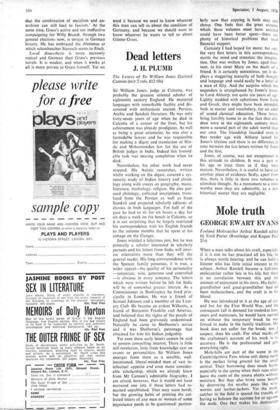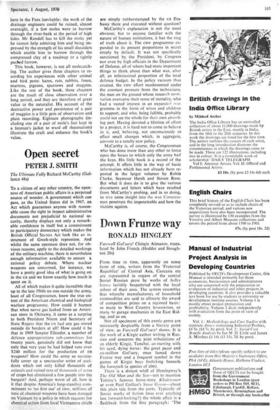Mole truth
GEORGE EWART EVANS
Fenland Molecatcher Arthur Randell edited by Enid Porter (Routledge and Kegan Paul 21s) When a man talks about his craft, especially if it is one he has practised all his life, he is always worth hearing; and he can hold a listener who has little initial interest in the subject. Arthur Randell became a full-time molecatcher rather late in his life, but there is no correlation between this and the amount of enjoyment in his story. His father. grandfather and great-grandfather had all been molecatchers, and the craft is in his blood.
He was introduced to it at the age of six; and but for the First World War, and the consequent fall in demand for moleskin hats. coats and waistcoats, he would have carried on without the temporary break he was forced to make in the family tradition. His book does not suffer for the break; nor, suspect, does his craft. For what marks off the craftsman's account of his work is its accuracy. He is the professional and gets everything right. Mole-hills are part of the scene in the Cambridgeshire Fens whose soft damp earth is the perfect living ground for the small animal. Their burrowing does much harm. especially in the spring when their runs often leave the roots of the young plants without moisture. But they also bring some benefit by destroying the smaller pests like wire- worms and leather-jackets. Yet the mole- catcher in the field is spared the trouble of having to balance the account for or against the mole. One fact makes his destruction
here in the Fens inevitable: the work of the drainage engineers could be ruined, almost overnight, if a few moles were to burrow through the river-batik at the period of high tides. Mr Randell has to kill the mole; yet he cannot help admiring him and being im- pressed by the strength of his small shoulders which enable him to burrow through the compressed clay of a roadway or a tightly packed furrow.
This book, however, is not all molecatch- ing. The author gives three chapters to re- cording his experiences with other animal and bird pests: hares, rats, rabbits, foxes, martens, pigeons, sparrows and magpies. Like the rest of the book, these chapters are the result of close observation over a long period, and they are therefore of great value to the naturalist. His account of the destructive power and persistence of a pair of magpies is a little gem of observation and plain recording. Eighteen photographs (in- cluding one of a pair of mole's feet kept in a fenman's jacket to ward off rheumatism) illustrate the craft and enhance the book's value.































 Previous page
Previous page